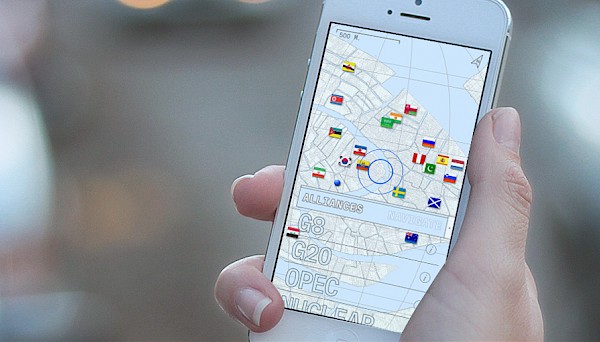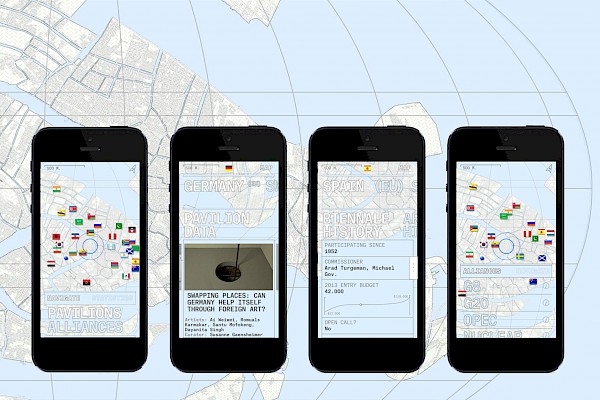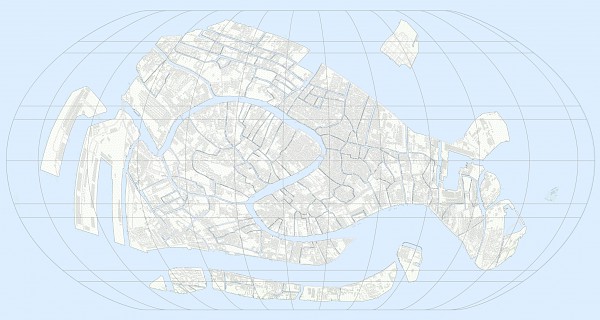Ideological Guide to the Venice Biennale
2013
The Ideological Guide to the Venice Biennale is a free smartphone application that provides information on the political, economic, and ideological framework of all national pavilions of the 2013 Venice Biennale. In 2013 this cultural manifestation, modelled after the world fair and in existence since 1895, comprised of about ninety national exhibitions, each attributed to a specific country. Through the Ideological Guide the pavilions are considered cultural embassies, where each country showcases the artists it believes to be most representative for the current developments in its art sector.
The organization of the pavilions of the Venice Biennale may be interpreted as an allegory of the global political order. In this context, curators and artists become ambassadors, and the artworks landmarks in the field of global political power play. Art in the context of the Venice Biennale does not imagine the world “differently,” but, rather, more accurately than it often presents itself: from the neighboring pavilions of the United States and Israel, to the claim of European colonial nations on the luxurious heart of the event known as Giardini, and the placement of the Palestinian Pavilion on the fringes of the city as a ‘collateral event.’ The geographical representation of Venice Biennale, in other words, could be regarded as an alternative world map.
The Ideological Guide to the Venice Biennial contains maps providing insight into how these underlying geographical politics correspond to the different contextual and subterranean aspects of the Venice Biennale -- its history, architecture, programming, board, funding, and so on -- as well as short articles on each pavilion written by prominent artists, theoreticians, critics, and philosophers from all over the world. Contributions by Abart (Amila Puzic and Anja Bogojevic), Peio Aguirre, Liane Al-Ghusain, Arie Amaya Akkermans, Yazid Anani, Luis Alarcón, Burak Arikan, Mercedes Azpilicueta, BAVO (Gideon Boie and Matthias Pauwels), BLOK (Ana Kutlesa, Vesna Vukovic, Ivana Hanacek), Cláudia Camacho, Libia Castro, Fredi Casco, Karen Charman, Sebastian Cichocki, Tamara Diaz Bringas, Megan Eardley, Grupo Etcetera (Loreto Garin Guzman and Federico Zukerfeld), Avi Feldman, Jeremy Fernando, Vincent van Gerven Oei, Lindsay Gordon, Nahela Hechavarría, Minna Hendriksson, Tammy Ho, Yota Ioannidou, Brigitta Isabella, Eva Khachatryan, Adam Kleinman, Robert Kluijver, Sebastjan Leban, Lim Lee Ching, Rosa Lleó, Matteo Lucchetti, Florian Malzacher, David Maroto, Slavko Martinov, Marco Mazzi, Emin Milli, Mihnea Mircan, Naeem Mohaiemen, Ahmet Öğüt, Sayuri Okamoto, Ólafur Ólafsson, Amilcar Packer, Ibrahim Quraishi, Ana Maria Saavedra, Elena Sorokina, Jonas Staal, Katharina Stadler, Syafiatudina, Milica Tomic, Jelena Vesic, Andreas Vrahimis, Joanna Warsza, Rhoda Woets, Mayee Wong, Work on Work (Hyejin Jang and Jaeyong Park), Stephen Wright, and several anonymous contributors.
-
Project by:
Jonas Staal
-
Project Team:
Jonas Staal (artist); Remco van Bladel (designer); Vincent W.J. van Gerven Oei (editor in chief); De Heren van Design, Thomas Boland, Matijs Eijkemans, Roel Oortgiesen, and Doeke Wartena (producers smartphone application); Younes Bouadi (producer); Renée In der Maur (research and production coordinator); Nadine van den Bosch, Réka Deim, Anna Maria Geluk, Alice Haddad, Suzie Hermán, Imara Limon, Marloe Mens, Sarah Merabai, Niki Liskov, and Ian Yang (researchers)
-
Supported by:
Kadist Art Foundation, Paris/San Francisco (FR/USA), The Farook Foundation, Dubai (UAE), Promoveren in de Kunsten, Amsterdam (NL), PhDArts, The Hague (NL), Center for Visual Arts, Rotterdam (NL), ArtEZ Academy Of The Arts, Interactive Design Department, Arnhem (NL)





